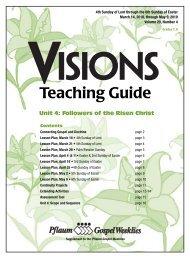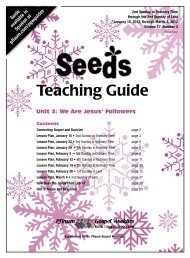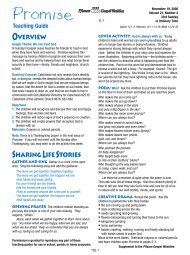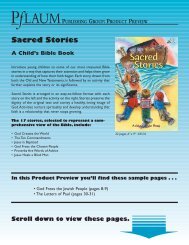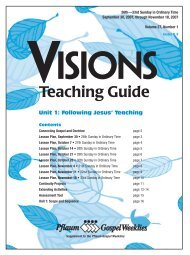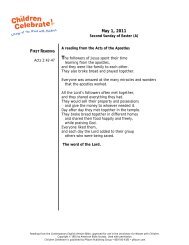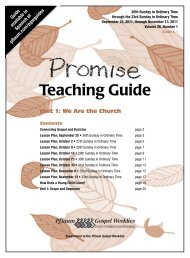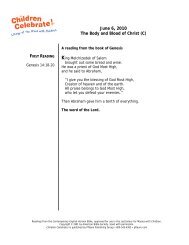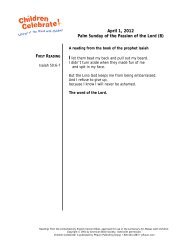Good News - Pflaum Gospel Weeklies
Good News - Pflaum Gospel Weeklies
Good News - Pflaum Gospel Weeklies
You also want an ePaper? Increase the reach of your titles
YUMPU automatically turns print PDFs into web optimized ePapers that Google loves.
Have a volunteer stand up. Pose a moral dilemma such as<br />
the one in this story. No one wants J.R. to be on their team<br />
at recess because he is not a very good player. You know<br />
he feels left out. You want to let J.R. play on your team, but<br />
you are afraid of what the other kids will say. What should<br />
you do?<br />
Ask a volunteer to stand on the red circle. Then ask the<br />
other children to tell you what that means. Have the child<br />
move to the yellow circle. Discuss with the class the questions<br />
the volunteer should ask or think about before he<br />
or she makes a decision about J.R. When the volunteer is<br />
ready, he or she should move to the green circle and tell<br />
everyone what he or she has decided to do.<br />
Play “Jesus Says,” based on “Simon Says.” Prepare statements<br />
ahead of time so you can keep up a quick pace.<br />
Everything that Jesus says should be good, such as, “Jesus<br />
says, “Say your prayers.” The others are bad choices, such<br />
as, “Tell a lie.” Children can respond to the statements with<br />
a thumbs-up or a thumbs-down.<br />
Virtues, page 30<br />
Ask children to define the word habit. What are some<br />
examples of good habits? What are some examples of bad<br />
habits? Explain that there is another kind of habit—moral<br />
habits. These habits are morally good or morally bad. <strong>Good</strong><br />
moral habits are called virtues. Some examples of virtues<br />
are kindness, truthfulness, generosity. Bad moral habits are<br />
called vices. Some examples of vices are cheating, disobeying,<br />
selfishness.<br />
Tell children that the word virtue comes from a Latin word<br />
that means strong. Ask them to find and underline the<br />
word strong on page 30. Read aloud the sentences in which<br />
strong is used.<br />
Then ask each child to make up his or her own superhero.<br />
The power of the superhero is virtue. Children can choose<br />
any virtue they want their hero to show. Give examples to<br />
get children started: Temperance Man, Justice Girl. Distribute<br />
art paper and markers. When everyone is finished<br />
drawing, take time to share the results. Discuss how they<br />
can imitate their hero’s virtue.<br />
God’s Law<br />
The Ten Commandments, page 31<br />
Go through the Ten Commandments, reading what each<br />
requires. Ask for examples of how children can keep each<br />
Commandment. You may need to make clear that fighting,<br />
getting angry, and hurting someone’s feelings are all sins<br />
against the Fifth Commandment.<br />
Discuss with children what it means for a person to examine<br />
his or her conscience. Help children write their own<br />
examination of conscience based on their discussion of the<br />
Ten Commandments. Give them lined paper to write out<br />
questions for each Commandment. Encourage children<br />
to go through these questions honestly every night before<br />
they go to sleep. They can end with the Act of Contrition,<br />
and try to do better the next day.<br />
The Great Commandments, page 32<br />
Help children see that the Great Commandments sum up<br />
the Ten Commandments. The first three Commandments<br />
tell us how to love God. The other seven Commandments<br />
tell us how to love others. The Great Commandments tell<br />
us how to love God and to love others as we love ourselves.<br />
The New Commandment—The Law of Love, page 32<br />
Read the text aloud. Ask children for examples of how<br />
Jesus’ law of love can help them learn how to love one<br />
another.<br />
The <strong>Good</strong> <strong>News</strong>, page 32<br />
Point out that this list summarizes what it means to be a<br />
Christian. Tell children that you will read each item. Invite<br />
them to respond after each by saying, That is good news!<br />
Read each item slowly and with expression. Wait for their<br />
response before going on.<br />
What Would You Do? page 33<br />
Answers:<br />
1. Fourth Commandment<br />
2. Seventh Commandment<br />
3. Fifth Commandment<br />
Keep My Commandments, page 34<br />
Suggest that children look up the Scripture passage to<br />
check their answer.<br />
Answer:<br />
If you keep my commandments, you will remain in my<br />
love, just as I have kept my Father’s commandments and<br />
remain in his love.<br />
If children enjoy this puzzle, challenge them to make up<br />
their own puzzles using the same picture code. Each can<br />
exchange his or her new puzzle with another child, and<br />
they can try to solve one another’s puzzles.<br />
PRAY<br />
The Bible Is a Great Prayer Book, page 35<br />
Invite children to look through the Book of Psalms with<br />
you. Explain that there are prayers here for every human<br />
feeling. Have the children find Psalm 23. Read it together,<br />
alternating verses between boys and girls.<br />
Then find Psalm 104:1-9. As you read, ask children to use<br />
their imaginations to let the words suggest pictures. What<br />
are their reactions to what they imagine?<br />
Invite children to write a short psalm of praise, similar in<br />
tone to Psalm 104. Encourage them to use their imagination<br />
and come up with vivid images. When they have<br />
finished, help them make corrections. Have them read<br />
their work aloud to see if it they like the way it sounds.<br />
13



